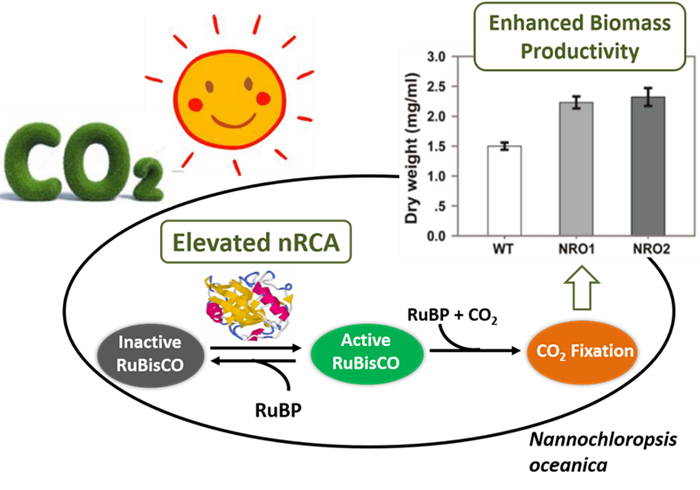QIBEBT Generated Super-microalga for CO2 Fixation
Microalgae can convert CO2 and solar energy to oil, which provide a potential solution for clean-energy production and value-added utilization of CO2. For the key question of enhancing the efficiency of microalgal carbon fixation, the Single-Cell Center at Qingdao Institute of Bioenergy and Bioprocess Technology (QIBEBT), Chinese Academy of Sciences (CAS) developed a novel microalgal feedstock development strategy towards superior carbon fixation, which significantly elevated the productivity of microalgal biomass and lipids. This new work was published on Algal Research.
One major bottleneck in industrial-scale deployment of microalgae for oil production has been their biomass productivity, which ultimately determines oil productivity. Over the years, in those model unicellular photosynthetic organisms, various attempts to genetically improve photosynthetic carbon fixation were made. The main strategies adopted were direct engineering of RuBisCO (Ribulose-1,5-bisphosphate carboxylase/oxygenase) itself, or regulating carbonic anhydrases that enrich CO2 concentration around RuBisCO. However, in industrial oleaginous microalgae, genetic engineering carbon fixation systems for higher productivity have not seen success.
The research team from Single-Cell Center discovered that, in the temporal transcriptomic data of the industrial oleaginous microalga Nannochloropsis oceanica under CO2 stress, a nuclear-encoded RuBisCO activase (nRCA) transcript showed upregulation at 12h, which implies it plays a role in CO2 fixation. RCA with ATPase activity functions as a mechanochemical motor protein and uses the energy from ATP hydrolysis to modify the structure of RuBisCO. Specifically, RCA facilitates carbamylation and thus maintains activity of RuBisCO by removing the various inhibitors from RuBisCO catalytic sites in an ATP-dependent manner.
Therefore, this RCA was overexpressed in the microalga. Compared to wild-type, under air-level CO2, microalgal growth rate was enhanced by ~32%, biomass accumulation by ~46% and lipid productivity by ~41%, which were also accompanied by ~28% elevation in photosynthesis. Furthermore, abundance of RuBisCO large subunit protein increased by ~45%, suggesting nRCA overexpression enhanced microalgal photosynthesis by upregulating the level and activity of RuBisCO. Thus the productivity of both biomass and lipids are simultaneously elevated.
In microalgae, biotransformation process from CO2 utilization to product synthesis can be divided into three key steps including “carbon capture”, “carbon partitioning” and “carbon storage”. In view of above success in “carbon capture”, Single-Cell Center is building on their past achievements in the other two steps, and has taken on a comprehensive, multi-target approach to design “super-algae cell factories” that feature efficient carbon fixation, precise product synthesis and scalable cultivation.
This work is supported by CO2 Biotransformation Program from CAS and the National Distinguished Young Scientists Program from NSFC.

Figure: Photosynthetic biomass productivity enhanced by overexpression of RuBisCO activase in Nannochloropsis oceanica. (Image by WEI Li )
(Text by WEI Li and XU Jian)
Contacts:
Prof. XU Jian, Ph.D,
Qingdao Institute of BioEnergy and Bioprocess Technology, CAS
Qingdao, Shandong, 266101, China,
Tel: 86-532-80662653
E-mail: xujian@qibebt.ac.cn
http://www.researchgate.net/profile/Jian_Xu8